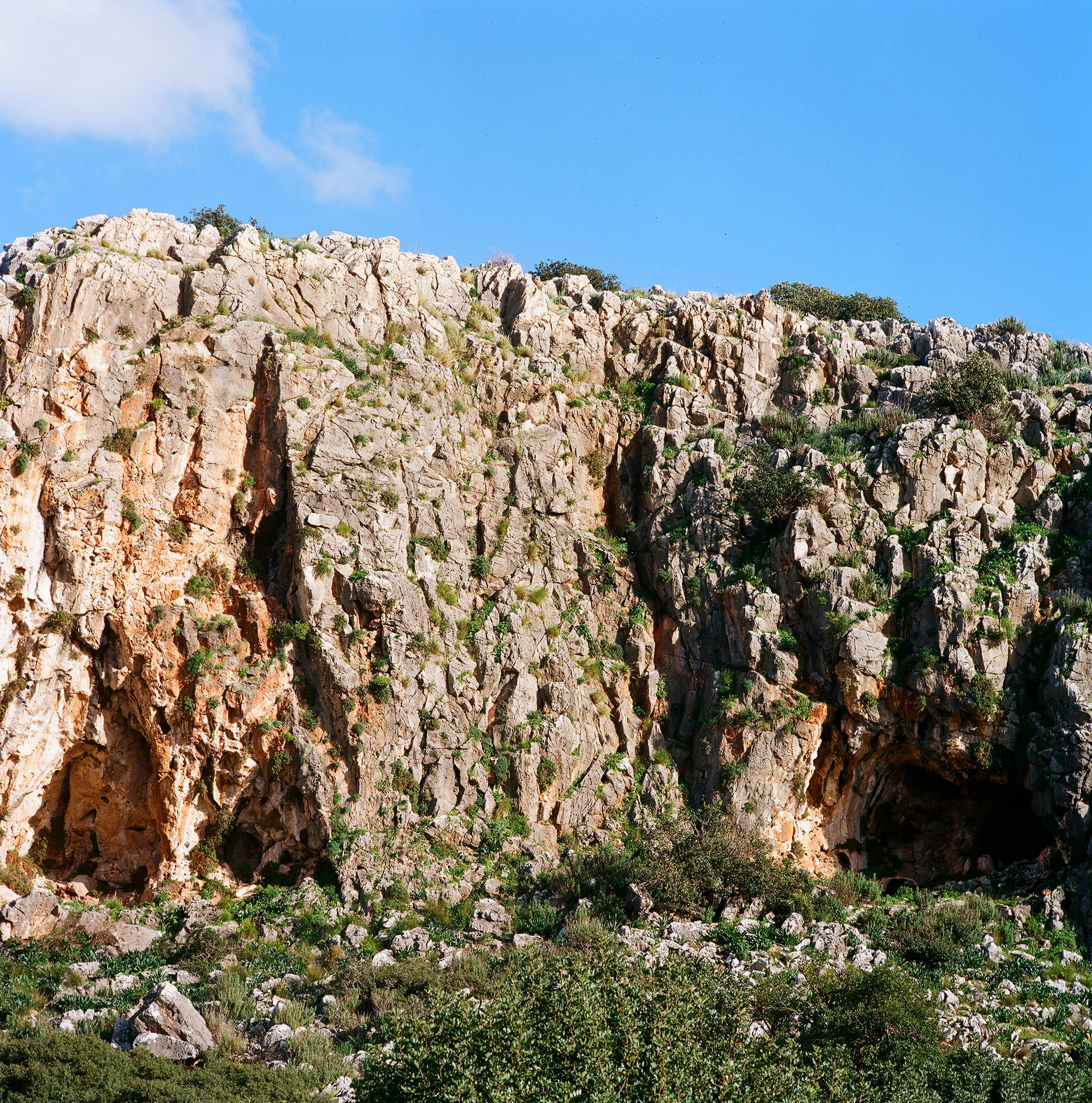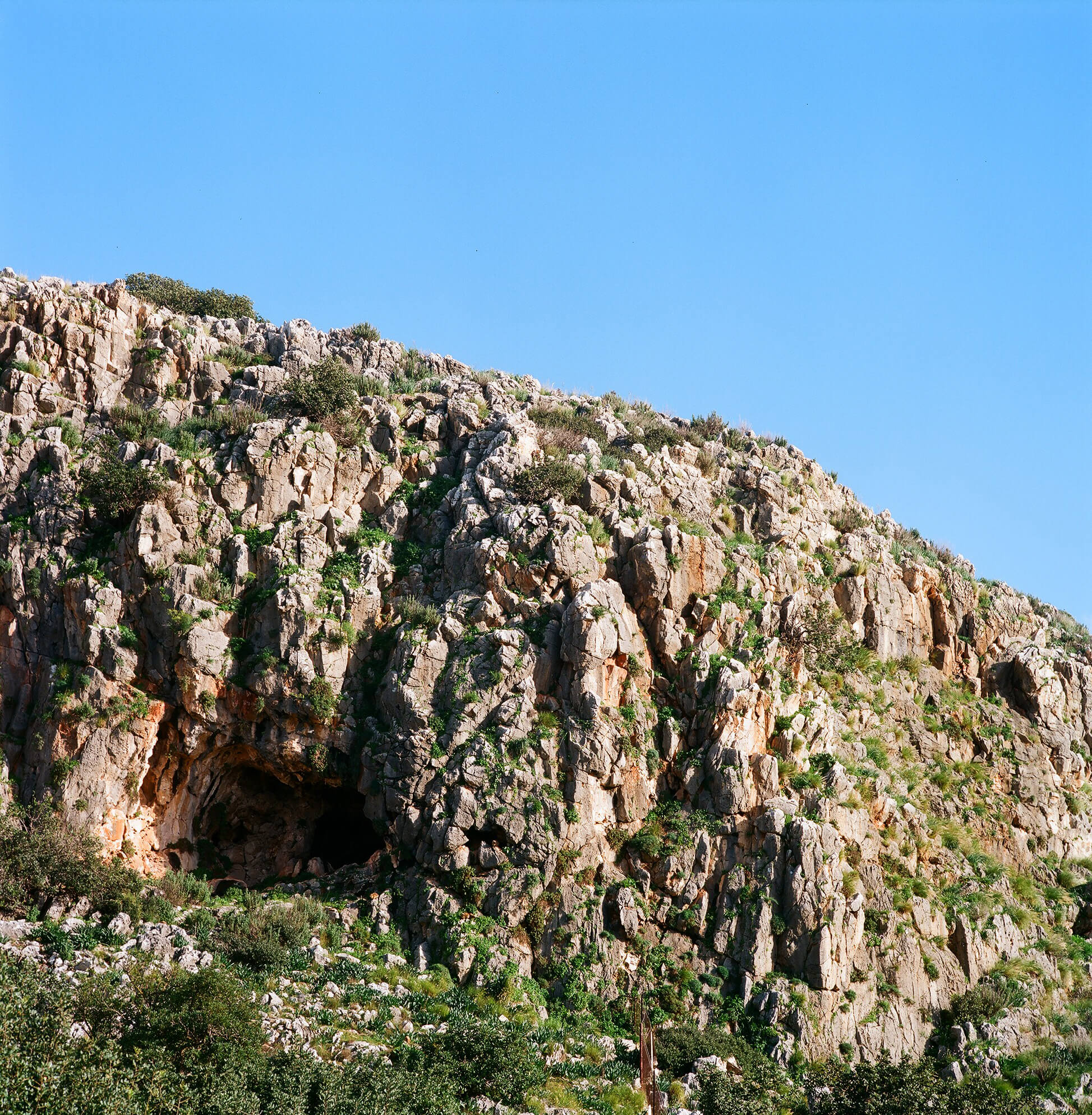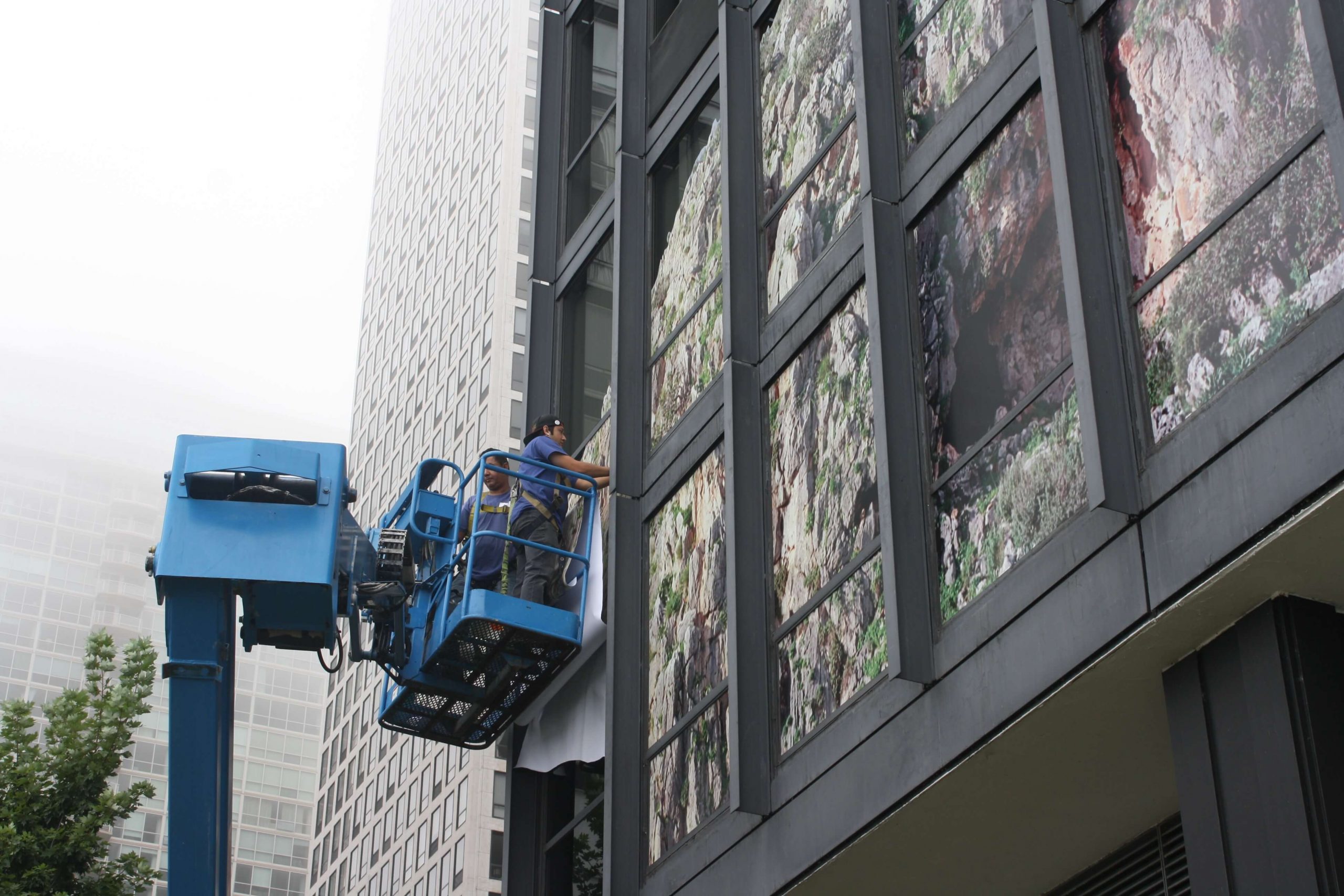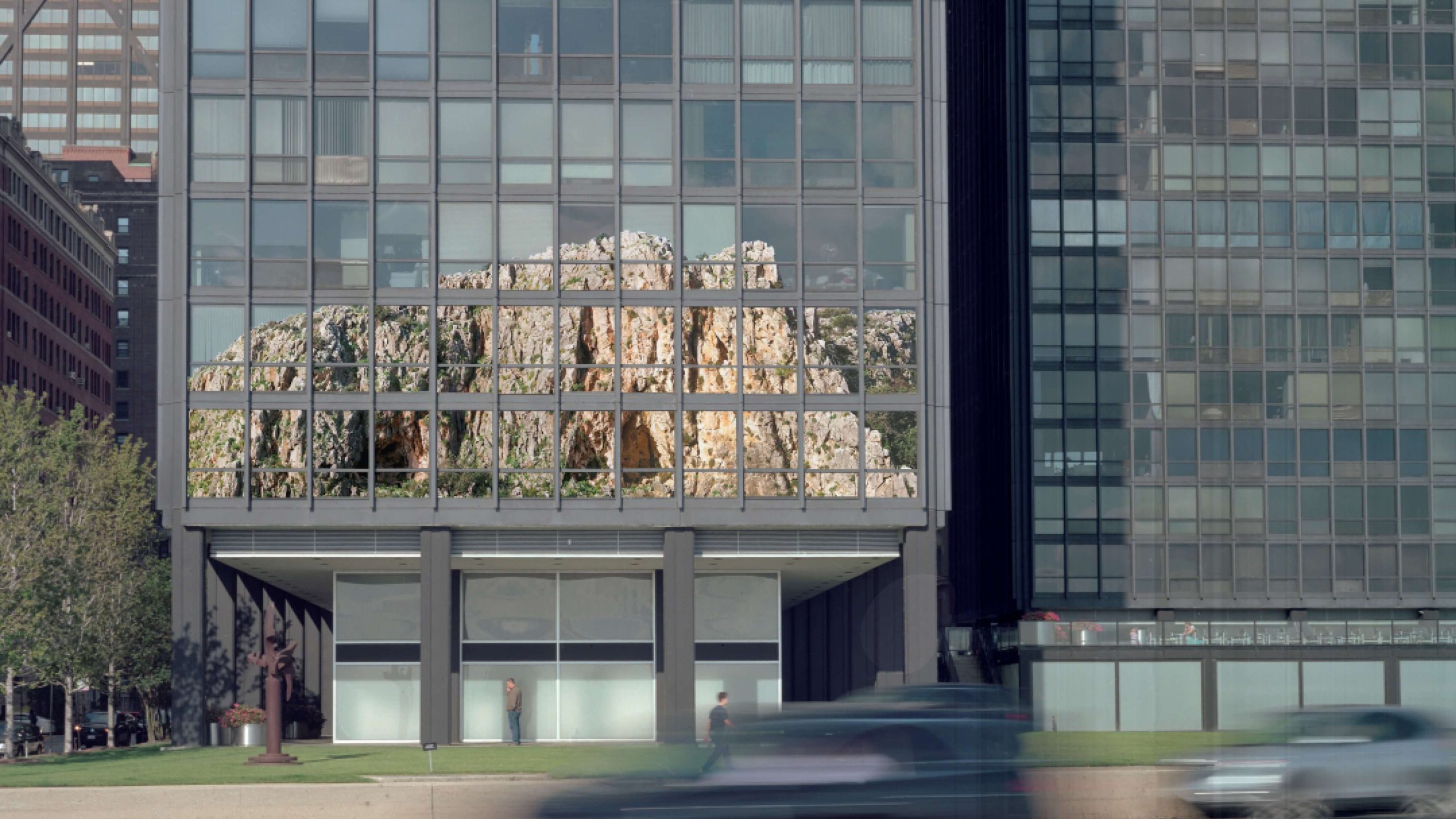In September of 2019, residents of 900 910 gathered for a ceremonious reveal of the first known artist installation the highrises have seen. Assaf Evron’s collage landscapes of cave dwellings and mountain ranges were applied to the exterior of three floors, visible from Lake Shore Drive. The concept was inspired by collages, created by Mies in the late 1930’s and after, that Evron recovered. The collages were created originally as an exercise to reconsider architecture, and suggest a more organic and abstract aspect to Mies’ work, which is often characterized as purely rationalist.
I sat down with Evron, to discuss the inspiration and intention for the conceptual installation, entitled Collage for the Esplanade Apartments; his upbringing in the hub for architecture in the International style, Tel Aviv; and his experience working with the building and its residents to realize his vision.
Ashley Lukasik: The possibilities for activating these historic buildings are incredibly exciting. I’d love to hear more about the history of the project because this is exactly the kind of unique experience in a non-traditional art space that people are craving.
Assaf Evron: For me, it was amazing because usually I work with institutions and here, I worked with individuals and the building association. So it was–on the one hand–challenging, but also very exciting. When you have a show in a museum, it opens, you have an audience coming in and out. But this was amazing because it made a huge difference for the people who live in the buildings. It was, for them, a celebration of the architecture they live in. A celebration of their life choices.
And it felt very meaningful in a different way.
AL: Tell me a little bit more about the project itself.
AE: The idea started with my interest in people that immigrated to the United States—especially the European modernists—and how their languages were distributed and modified as they traveled around the world. And Mies, of course, is one of the big figures that moved from Germany and reinvented architecture as we know it. And he has a very strong presence in Chicago. As a kind of father figure of Modernist architecture, a lot of Postmodern thinkers… have an Oedipal Complex with him. He’s the one that they like to hate.
(laughs)
AL: Right.
AE: He is rational, systematic, rigid. Grid-based architecture. And reductive. Non-expressive. The negation of which are all the things by which Postmodernism defines itself. I was looking at the collages Mies made when he came to the United States. He made really special collages—they are very unique.
Usually when architects make collages, you expect them to render a building in an environment. No doubt, that’s what he did in Germany. But when he came here it wasn’t about the building as an object. It wasn’t about the exterior of the building. It was actually about the interior, about dwelling. It was conceptual–not necessarily operative–collage where he negotiated artworks, materials, and landscape, within the set up of the grid architecture.
As an artist, I was very interested in the materiality of the collages. When you look at them you see that Mies cut and pasted landscape photographs into the windows of the building in order to illustrate the landscape that is seen through the window. He did that to illustrate the transparency of the window and its function as a viewing device. And I was thinking why don’t I use his strategy of collage and apply it onto his buildings? I wanted to see what would happen when his representations of architecture and his own architecture collapse onto each other.
I wanted to consider questions about landscape, the objecthood of architecture, and its materiality. And also address architecture’s relationship to the natural world, or how they are merging into each other. Nature and architecture are superimposed onto each other.
The first building that I did was the McCormick House at the Elmhurst Art Museum. I installed a geological landscape onto the exterior windows. It was a gesture that solidified the house into one geological strata. The house looks as if you took one floor out of a high-rise and put it in a field as a single family house. Within the house, there’s also an interesting response to Mies’ own history. I made curtains with landscapes from Germany before 1938. Geology from the Dead Sea in Israel on the outside and the German Alps from before 1938 on the interior.
I started to make paper collages of my own. I photographed a lot of Mies buildings in Chicago and superimposed them with landscapes. Once I had the collage concept in mind, I started to approach people at the buildings to propose the project. So again, the first one was at McCormick House and the Esplanade Apartments was the second one.
The Esplanade Apartments was kind of a challenging project–to think about what would be the right image for them and also where to place the collage on the building. I had to consider the geography of the building and how people experience it from the city, and have the installation respond to that. If it was too high it would be a nice conceptual work but nobody would see it. So it was important to me to have it interact with people who walk and drive on Lake Shore Drive. So I kind of anchored the building down with the photograph. The thing that was important to me—not only to anchor it down, but go from side to side and kind of acknowledge the objecthood of the building.
The first images I was testing were mountain ranges, but I wanted to think about something that has more layers. Mies’ buildings of Lake Shore Drive were the first residential highrises at that scale. It was a new way of dwelling in vertical architecture. So I was looking at cave dwellings. I was looking at mountain ranges that are also a location of cave dwellings.
I traveled to many places to look for them, but a lot of them were manmade and I wanted some kind of found architecture.
I found these prehistoric caves, natural caves, that pre-humans lived in for half a million years. Actually I used to take my kids there when we lived in Israel. So the mountain range is kind of a found object or found architecture—people said oh, this is an interesting place that can accommodate our needs so why don’t we live in it? Conceptually highrises were also a new way of living–to stack houses and live in that kind of similar physicality.
That was the idea and we just had to put them on the windows.



Panorama segments for the installation
AL: How big was it at the end?
AE: At the end it was 12 windows wide over three floors high, something like 60 feet wide.
AL: People love to interpret Mies’ work as lacking emotion or lacking “the person”. But his spaces lend themselves in a quite flexible way to all these different artistic interventions. There have been a number of them. It’s really stunning.
900 910 are exciting too, because they are residential buildings. They’re alive. People are putting their own stamp on them just by virtue of their experience living there.
AE: Yea, and what you’re saying about the artwork is also reflected in the interiors. I was lucky to visit a lot of the apartments. It’s interesting how the building enables many different kinds of living within the strict architecture.
There’s a lot of research now about Mies. He was more interested in the natural world—and relationship to the natural world—than one could or wanted to imagine in the second part of the 20th century.
AL: His commitment to making you feel like you’re almost on the lake when you’re in those units, especially now, seems so important.
Part of our disconnection and alienation from nature—the many layers we have put between ourselves and what it means to be human animals—is partly why we find ourselves in a difficult position. The problems we are facing are so terribly complex and we don’t have a way of looking at them that feels rooted to our own lived experience, not mediated by technology or media.
But at 900 910–even on quarantine like people have been–you still have that sense of connection to the natural world all throughout, even if you literally can’t walk outside.
AE: In the 20th century there was the idea of the dichotomy of culture and nature. Culture in modernity alienated and differentiated itself from nature. However, I think that nature is culture and culture is nature.
One of the ideas of this work is that they both collapse into each other and merge, rather than to be on two sides of the window.
AL: The other thing that makes the buildings and all of Mies’ work so striking now, is that it is so intentional, purposeful, and stable at a time when we’ve been on a trajectory of designing for obsolescence. Fleeting, trendy, everything thrown away, and replaced within a short period of time. The feeling of something that has a permanence because of its quality feels more meaningful now than ever.
AE: Definitely, and there’s another layer to that in thinking about vernacular architecture—architecture that is specific to a place and time. Mies came here and said “okay what do we have here? Industry has glass and steel so let’s find an efficient way to make a building out of that.”
AL: Are you saying that it was adaptive to the existing conditions and what was happening locally?
AE: Yes it was an “international” style—it doesn’t matter where it is exactly. A lot of critics of Modernism say it doesn’t acknowledge the place. However, I think there’s a lot of consideration to the place and the materials that were available in the industry at that time.
AL: With Mies you have an incremental approach to refinement, which you see at 900 910 because it’s kind of a perfection of some of the buildings that came before and some of his earlier ideas. He fully realizes the curtain wall and other details.
What I think is really interesting about your intervention and other ways that artists are reinterpreting or building upon Mies’ work is that it feels process-driven and kind of inclusive of human relationships around the world.
AE: Definitely. I think there are two motives for artists. There are artists doing the same thing and perfecting it throughout their career, and there are artists interested in many things and every project is a thing on its own. It’s harder for the second artist.
AL: Nowadays we’re a lot more comfortable with playing with lots of mediums. That’s why I think a lot of people have revisited Mies’ work, interested in bringing their own interpretations to it. I think that pulling from both artistic approaches and bringing them together in a meaningful way, in a historically relevant architectural space, to me is almost like today’s Bauhaus.
AE: Yea, definitely. And it’s an amazing thing to be in Chicago. Where else in the world would people let me put stickers on a Mies van der Rohe building? (laughs)
Who would let me do that? And it was amazing because I approached the building and it was an immediate yes. It was a long road, but it was an immediate yes, like “sure, why don’t we do that? It sounds like a cool project.”
AL: I would have loved to have visited each of the individual units.
AE: Yea, definitely. And it’s an amazing thing to be in Chicago. Where else in the world would people let me put stickers on a Mies van der Rohe building? (laughs)
Who would let me do that? And it was amazing because I approached the building and it was an immediate yes. It was a long road, but it was an immediate yes, like “sure, why don’t we do that? It sounds like a cool project.”

Installation of Collages for the Esplanade Apartments
AL: Tell me a little more too about the process of engaging with the residents. How long were you working on the project?
AE: A little over a year. From one presentation to another, we expanded the community involved in the project. Once we had identified the right tenants to collaborate with, we focused more on figuring out what would be the right installation. One challenge was figuring out the legal agreement, and the insurance—how do you protect everyone? As an artist working with museums you never think about those things. I learned a lot.
AL: One little scratch could be very significant. Say more about the event at the end, the unveiling of the project. And you did something on the sundeck?
AE: Yes, the esplanade. The event was like a little wedding!
AL: Really?!
AE: Yes, there were a lot of people but also it was very intimate. Everyone came down from the buildings, and everyone we invited came over. So it was feeling very, very special. There was a ceremony where we cut the ribbon and then everyone went for a party on the sundeck.


AL: Do you mind telling me more about your background and perspective as an artist? How long have you been interested in Mies and the Bauhaus?
AE: Well, I grew up near Tel Aviv.
AL: Which has a lot of Bauhaus.
AE: Exactly. Tel Aviv is World Heritage for International Style. Bauhaus is part of that. The logic of the Bauhaus was the rationale behind the architecture in Israel as a whole. A lot of architects were studying the Bauhaus or similar schools at the time. They applied what they learned in Europe into Israeli architecture. I was living in Bauhaus without knowing what Bauhaus is. Only retrospectively did I realize the context. It was part of a wider phenomena that had a utopian horizon that failed in a way in Israel.
It was interesting to think of this idea of Modernism that might be successful elsewhere.
AL: So in a sense it was always a part of your aesthetic and your life.
AE: Definitely. It was existential. Your mode of being is determined by the architecture you live in.
AL: That’s fascinating.
AE: So the interest was there in Modernism. I started my career as a photojournalist. I studied for an MA in philosophy and later an MFA in photography. The two merged together in my art practice, that is image based, with thinking about philosophy and the history of ideas and how they operate and activate our present time.
AL: I loved your installation at the MCA. I thought it was great. Jan Tichy just did the installation at the God Box (Mies’ Carr Chapel at IIT) that was dealing with occult practice in the Bauhaus. My feeling is that people are looking to the mystical sciences or to the roots of our being for answers, in a period characterized by existential crises. I felt there was a subtlety to that theme that was emerging in your work as well.
AE: Modernism by default has a spiritual aspect. It is based on the belief of a better future. Thinking about Germany in the early 20th century, many artists and architects were experimenting with spirituality and occult in their materiality, looking into nature and using natural forms in their architecture.
But for the same reason–like all utopian ideas—it also embeds its own failure…
If Assaf’s installation is any indication, we can look forward to amazing future interactions between our city’s great artists and 900 910.
Assaf Evron is a Chicago-based artist and photographer. His work has been exhibited in galleries and museums internationally. Evron holds an MA from The Cohn Institute at Tel-Aviv University, as well as an MFA from the School of the Art Institute of Chicago. He has received numerous awards including: Illinois Art Council Fellowship (2020), The Graham Foundation (2017, 2019), DCASE (2019), Artis (2016, 2019), The Gerard Levy Prize from the Israel Museum in Jerusalem (2012), and The James Weinstein Fellowship from SAIC (2013). He teaches Contemporary Practices at the School of the Art Institute Chicago.

